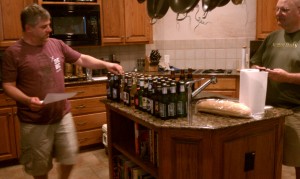Multiple posts per week and then no new posts in almost two weeks…traffic to the blog is dropping…dust is collecting.
Several things have been going on in my world as of late. In addition to that whole “job” thing and having a family, I’ve been busy working on beer recipes, brewing, piecing together a new homebrewery (including building a couple pieces of equipment), drinking new beers, doing a lot of reading and research, and doing a lot of planning.
All Grain Brewing
One of the things I’ve been busy with is going all-grain (that is, brewing without the use of malt extract). This requires more equipment and makes for a longer brewday, but I feel more connected to the process. Besides, this is the “real” way to brew beer. My first all-grain batch was a relative success. I brewed EdWort’s Haus Pale Ale (a pretty famous homebrew recipe) with a bunch of new equipment (a keggle, a 10 gallon cooler mash/lauter tun, a 50′ immersion chiller, etc.). So I was brewing a new-to-me recipe on new equipment using a new process. What could go wrong? Actually, if it wasn’t for my digital thermometer that gave up the ghost while I was mashing in, I think everything might have turned out rather well.
What happened was this…I had heated my strike water to the proper temperature and was in the process of doughing in when I noticed my thermometer said the mash temperature was over 200 degrees. I quickly grabbed a gallon of cold water (I used bottled spring water so I didn’t have to work about pH and chloramines so much) and poured it in to cool the mash down. I then realized the thermometer was reading about 55 degrees warmer than it should. I tried a boiling water addition to get the mash back to my target of 152 degrees, but it didn’t help much. By that point, I had a very wet and cold mash. I would have had to add about 2-3 gallons of boiling water to get the temperatures where I wanted. I decided instead to dump the whole mash in my kettle and heat it while constantly stirring to prevent any burning. This worked very well, actually and I hit my temps perfectly. After a 60 minute saccharification rest, I drew about 4 quarts out of the mash, heated it to boiling, and added it back to the mash to “mash out.” I batch sparged as planned and proceeded with my boil (without measuring the gravity first).
After the boil, I chilled and transferred to the fermenter. I managed to hit my target original gravity exactly but I had somehow ended up with much more wort than I had expected (I probably collected about a gallon extra). It’s been in the fermenter for two weeks now, so I can’t fully judge how well it turned out. I also haven’t gotten around to measuring the final gravity, but since I had such a wet mash, I anticipate that the wort might not be as fermentable as I had planned. All in all, I’m quite pleased that I was able to recover from the thermometer issue and I think I learned more about the process (such as getting to employ decoctions, which I had read about but wasn’t planning on doing) than I would have otherwise.
The Blog Itself
I’m going to be completely honest and say that the task of writing the posts about the BJCP classes/tasting (which tend to be about 2500-3500 words) is very daunting and time-consuming. I want to continue doing this as I think it’s pretty good content for the blog and its a good way for me to study for the upcoming exam, but it sure is a lot of work. I take ample notes at each class (the last was ~2 weeks ago) but transferring my shorthand into meaningful words and adding the little snippets of history/background for each style is what takes so long.
Beyond that, I’m still trying to find a focus for the blog. I’m struggling to decide what subjects I 1) know enough about and 2) am interested in enough to write about that would result in posts that people would actually want to read. While I’m not trying to gain a huge group of readers by any means, it is important to me that at least a few people read what I’m writing…otherwise what’s the point? So I guess you could say that I’m still trying to find my voice. I really admire The Mad Fermentationist and ZymurGeist blogs. Each one seems very focused without becoming too specialized (if that makes any sense). I think FermNation is scatter-brained.
So as I move forward I have to remember that the reason I started this blog was as an outlet for my beer/brewing thoughts and as a way to help me build my knowledge and discover my “beer voice” (and I don’t mean slurred speech after one too many). Once the BJCP class has ended, I’ll have to find a new primary focus for the blog. Whether it will remain a discussion of beer styles or move more toward homebrewing, the craft beer industry, or exploring the multitude of beers that are awesome but don’t fare well on BeerAdvocate / RateBeer is yet to be determined.






